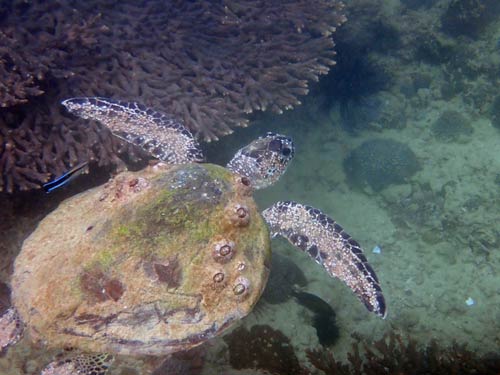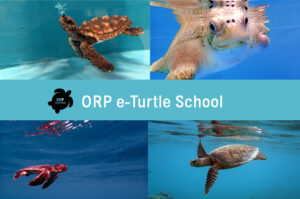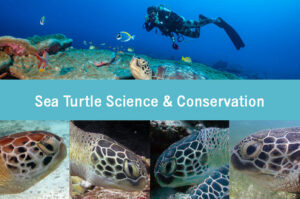Click to watch a short video about barnacles.
Barnacles are a highly specialized group of crustaceans. They have developed a sessile lifestyle as adults, attaching themselves to various substrates such as rocks, ships, whales or to sea turtles. Most commonly found barnacles on sea turtles belong to the genus Chelonibia, named after their host (Chelonia = turtle).


Initially, barnacles produce larvae. These early life stages are still mobile and facilitate further distribution. After the first six different so-called nauplius larvae, a seventh non-feeding larva develops: the cyprid. This is the stage which settles on a new substrate. The cyprid larvae has special attachment devices which allow it to hold onto the substrate, e.g. cup-shaped attachment organs on the antennae. Once settled, the barnacle develops into an adult and attaches in various ways: gripping the skin, cementing to the shell or boring into it.
Adult barnacles are filter feeders, thus benefit from a constant flow of water around them. As sessile creatures they can achieve that by a) settling in an area with pronounced water movement (e.g. close to shore) or b) settling on a moving substrate such as a sea turtle.
Even though barnacles are quite safely attached, barnacles actually are capable of moving as adults! They most likely achieve this through an extension of their cemented base as well as through muscle activity.
Most barnacles do not hurt sea turtles as they are only attached to the shell or skin on the outside. Others though burrow into the skin of the host and might cause discomfort and provide an open target area for following infections.
Excessive barnacle cover can be a sign of general bad health of a turtle. Usually sea turtles are debilitated first, and then become covered in an extensive amount of other organisms, such as barnacles and algae.
Luckily turtles are very resilient and can sometimes recover from such infestations.
Read more about Sea Turtle Hitchhikers – The Symbiotic Relationships of Sea Turtles here.
Learn More About Sea Turtles – Free Online Courses
e-Turtle School – All about sea turtles
Everything you have ever wanted to know about sea turtles, from evolution to conservation. Suitable for all sea turtles lovers and those who want to learn more about these fascinating creatures.
Sea Turtle Science & Conservation
Deep dive into sea turtle science and conservation. Suitable for budding conservationists and those with an interest in the science surrounding turtles, their biology and conservation.
References:
- Monroe R & Limpus CJ 1979. Barnacles on turtles in Queensland waters with descriptions of three new species. Memoires of the Queensland Museum 19: 197-223.
- Moriarty JE, Sachs JA & Jones K 2008. Directional Locomotion in a Turtle Barnacle, Chelonibia testudinaria, on Green Turtles, Chelonia mydas. Marine Turtle Newsletter 119: 1-4.
- Zardus, JD & Hadfield MG 2004. Larval development and complemental males in Chelonibia testudinaria, a barnacle commensal with sea turtles. Journal of Crustacean Biology 24: 409-421.
- Monroe R & Limpus CJ 1979. Barnacles on turtles in Queensland waters with descriptions of three new species. Memoires of the Queensland Museum 19: 197-223.Ross A & Frick MG 2007.
- From Hendrickson (1958) to Monroe & Limpus (1979) and Beyond: An Evaluation of the Turtle Barnacle Tubicinella cheloniae. Marine Turtle Newsletter 118: 2-5.



